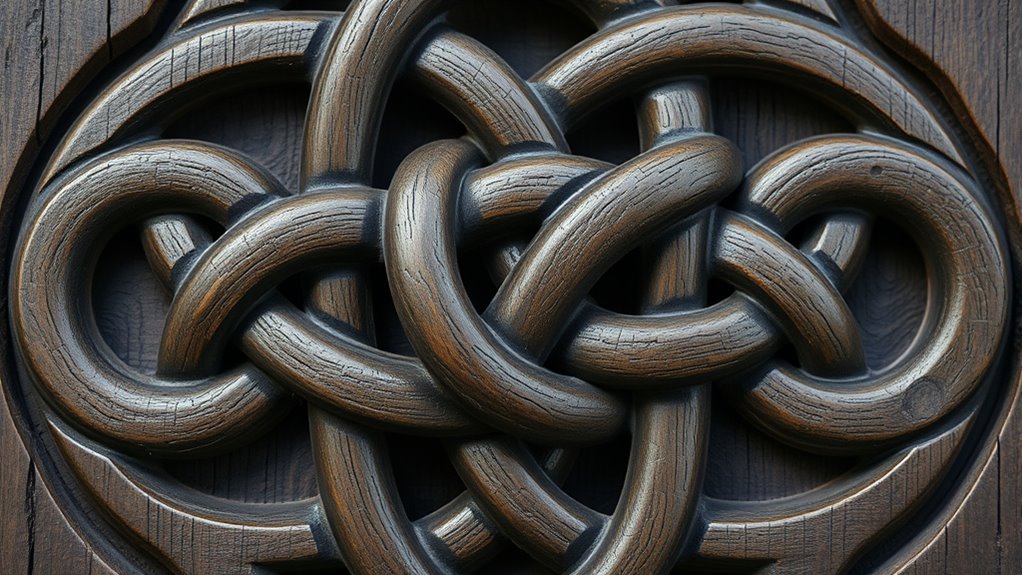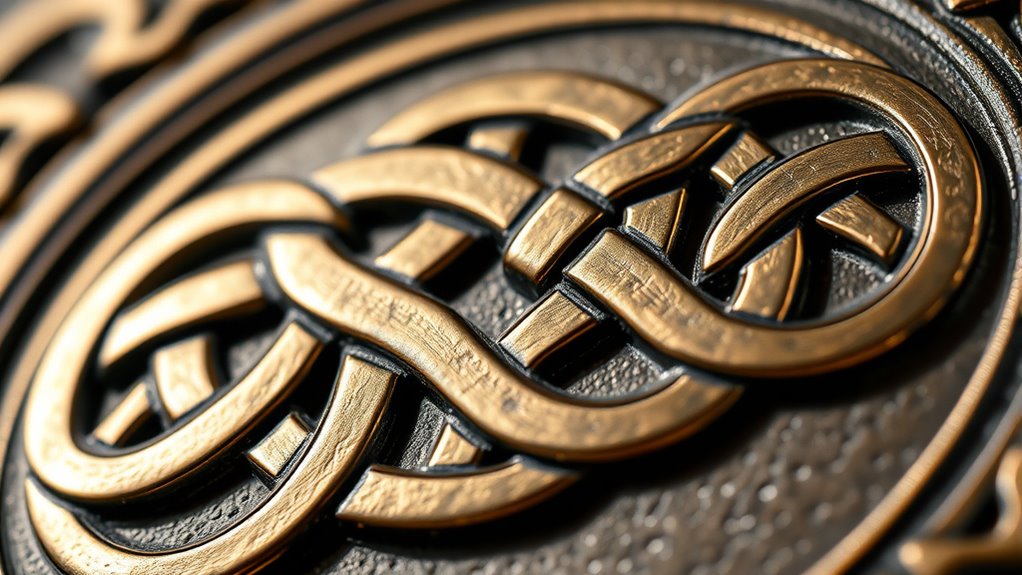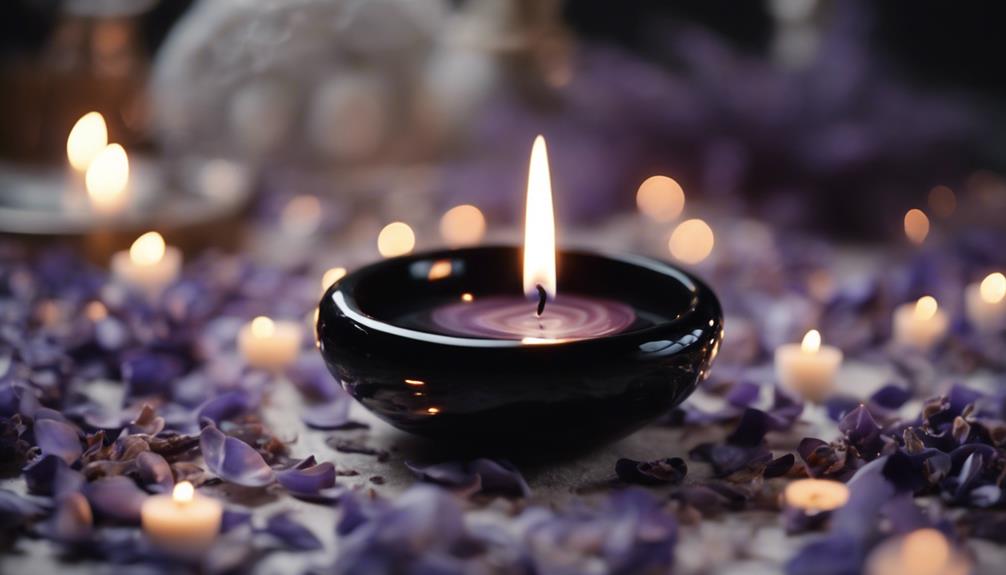Celtic knots are intricate, interwoven patterns that date back over 3,000 years, symbolizing eternity and interconnectedness. These designs represent concepts like infinity, loyalty, and spiritual growth, often without a beginning or end to emphasize timelessness. They serve as cultural symbols, reflecting unity, harmony, and the spiritual beliefs of Celtic tradition. If you continue exploring, you’ll discover how these timeless patterns continue to inspire modern art and hold deep cultural significance.
Key Takeaways
- Celtic knots are ancient, interwoven patterns symbolizing eternity, unity, and interconnectedness across spiritual and cultural contexts.
- The continuous, unbroken loops represent the infinite nature of life, the soul, and divine harmony.
- These intricate designs often convey meanings related to love, loyalty, faith, and spiritual growth.
- Evolving from decorative to symbolic, Celtic knotwork is a cultural identifier with deep spiritual significance.
- Modern adaptations of Celtic knots honor their legacy, symbolizing life’s endless cycle and interconnected human experience.

Have you ever noticed the intricate, looping patterns that weave seamlessly into endless designs? These enthralling patterns are the hallmark of Celtic knots, which have fascinated people for centuries. The symbolism in art embedded within these interlaced designs reflects deep spiritual and cultural meanings, making them more than just decorative elements. As you explore the history of knotwork, you’ll discover that these patterns are among the oldest and most enduring symbols in human history. Celtic knots originated in ancient Ireland and Britain, dating back over 3,000 years, and they were initially used in stone carvings, metalwork, and illuminated manuscripts. Over time, they evolved into a visual language representing eternity, interconnectedness, and the cycle of life, death, and rebirth.
Celtic knots, over 3,000 years old, symbolize eternity and interconnectedness in art and culture.
The history of knotwork reveals how these intricate patterns served as more than ornamental designs—they embodied spiritual beliefs and cultural identity. Early Celtic artisans used knotwork to adorn religious artifacts, jewelry, and monuments, believing the endless loops symbolized the eternal nature of the soul and the divine. These patterns often lack a beginning or end, emphasizing the concept of infinity. As you study their development, you’ll see how knotwork became a universal motif in Celtic art, symbolizing unity and the interconnectedness of all living things. This enduring symbolism in art connects modern viewers with ancient traditions, making Celtic knots a timeless expression of cultural heritage.
Understanding the symbolism in art behind Celtic knots allows you to appreciate their deeper significance beyond aesthetics. Each loop and weave can represent concepts like love, loyalty, faith, and spiritual growth. For example, some patterns are designed to symbolize the interconnectedness of family or community, illustrating how individual lives are woven into a larger, unbreakable fabric. Others might portray the harmony between the physical and spiritual worlds. When you see these knots in jewelry, tattoos, or architectural details, you’re witnessing a visual language that has conveyed profound meanings for thousands of years. Recognizing the symbolism in art embedded in Celtic knots enriches your appreciation for their beauty and cultural importance.
In essence, Celtic knots are a tribute to human creativity and the universal desire to find meaning in intricate patterns. Their history of knotwork reflects a long-standing tradition of using art as a vessel for spiritual expression, cultural identity, and philosophical ideas. As you observe or create these designs, you’ll connect with an ancient tradition that celebrates the endless cycle of life and the interconnected nature of all things. Celtic knots continue to inspire and symbolize, reminding us of our shared human experience woven into the fabric of history and art.
Frequently Asked Questions
Are Celtic Knots Unique to Specific Regions or Cultures?
You’ll find that Celtic knots are not entirely unique to one region or culture; instead, they show regional variations and cultural symbolism across Celtic communities. Different areas emphasize specific patterns and meanings, reflecting local beliefs and traditions. By exploring these variations, you’ll see how Celtic knots serve as a visual language that connects various Celtic cultures, highlighting their shared heritage while also celebrating regional identities.
How Are Celtic Knots Created in Modern Jewelry?
You create Celtic knots in modern jewelry using metalworking techniques like soldering, engraving, and casting. You can incorporate modern design trends by experimenting with different metals, such as silver or gold, and combining traditional interlacing patterns with contemporary styles. By blending these techniques and styles, you craft unique, meaningful pieces that honor Celtic symbolism while appealing to current fashion preferences. This approach allows your jewelry to stand out and carry cultural significance.
Do Celtic Knots Have Any Connection to Christian Symbolism?
You might think Celtic knots are purely decorative, but they do connect to Christian symbolism. These intricate designs often symbolize eternity and unity, reflecting religious symbolism and spiritual significance in Christian tradition. Their continuous, unbroken lines represent the eternal life and the interconnectedness of faith, making them more than just art. So yes, Celtic knots carry deep spiritual meanings that resonate with Christian beliefs and spiritual concepts.
What Materials Are Traditionally Used to Craft Celtic Knot Artwork?
You’ll find that traditional Celtic knot artwork is crafted using materials like metal, wood, and stone, often shaped with metalwork techniques such as filigree or engraving. Artists also use natural dyeing to add vibrant colors to fibers like wool or linen. These methods give Celtic knots their intricate, enduring beauty, blending craftsmanship with natural materials to create meaningful, lasting designs.
Can Celtic Knots Be Customized for Personal or Spiritual Meanings?
You can absolutely customize Celtic knots to reflect your personal symbolism and spiritual meanings, turning the intricate loops into a mirror of your soul’s story. Think of the knots as a canvas where you weave your intentions and beliefs, creating a design that resonates deeply. By choosing specific patterns or adding meaningful symbols, you craft a unique piece that embodies your journey, spirituality, and personal connections.
Conclusion
As you explore Celtic knots, think of them as life’s endless journey—each twist and turn symbolizing the interconnectedness of your experiences. I once heard a story about an artist who saw her own struggles reflected in an intricate knot, reminding her that even in chaos, there’s beauty and unity. Just like those timeless designs, your story weaves together challenges and triumphs, creating a continuous loop of growth and meaning that’s uniquely yours.











